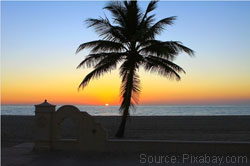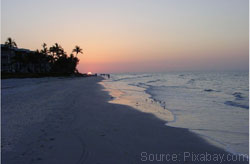 Situated in the southern most part of the sunny state of Florida, just north of Miami and the Florida Keys, Coral Springs is a slightly more modest version of its neighboring party cities, but can hold its own nonetheless.
Situated in the southern most part of the sunny state of Florida, just north of Miami and the Florida Keys, Coral Springs is a slightly more modest version of its neighboring party cities, but can hold its own nonetheless.
In 2010, the city was ranked among CNNMoney.com's Best Places to Live in the U.S., and has a large broadcast radio market due to its proximity to Miami and Fort Lauderdale. If you're considering relocating to Coral Springs, take a look at the following guide for helpful tips and information to do so.
Coral Springs Climate
The city's climate is characteristic of a humid subtropical climate, with hot and humid summers paired with mild winters. Between fall and winter, temperatures generally range from the high 60s to mid 70s, but can reach temperatures into the 80s.
The summer months in the city are hotter, with temperatures in the 80s and 90s, generally, with afternoon rain between July and August. The area is also susceptible to hurricanes and tropical storms.
Coral Springs Neighborhoods
You won't find too many tall buildings in Downtown Coral Springs, or anywhere else in the city for that matter - the city's building codes don't allow for structures much taller than 12 stories. The tallest building in the city is Country Club Tower, a residential condominium structure. Other tall buildings in downtown include Preferred Exchange Tower, 210 Tower and Bank of America Center. The city implemented these building codes as to not take away from the aesthetic of the city.
Coral Springs is a planned community, owned and developed by WCI Communities, formally Coral Ridge Properties. There are over two dozen smaller residential neighborhoods to choose from in the Coral Springs area, including areas along Royal Palm Boulevard, Ramblewood Drive and Coral Ridge Drive. Some families also choose to live in neighboring Parkland, for its park-like feel and recreational activities.
Registering Your Car
If you're becoming a permanent Floridian, you have 10 days to register your car in Florida from the date you begin working in the state, or register a child in a Florida school. You must have proof of ownership of your vehicle, verification of your VIN (Vehicle Identification Number), and proof of Florida insurance requirements.
You have 30 days to transfer your existing out of state driver's license to a Florida driver's license. To do so, you will need your primary identification, proof of Social Security number and two documents verifying your Florida address. The Florida DMV issues over 400,000 new resident licenses per year, and advises you to know your requirements and have your documents ready prior to going to the office.
Coral Springs Schools
There are over 30,000 students enrolled in the public school system in Coral Springs, which is served by Broward County Public Schools. BCPS operates three high schools, four middle schools and 12 elementary schools within the city.
For higher education opportunities in the area, students can attend Broward College, Nova Southeastern University and Barry University.
Coral Springs Employment
As of February 2013, the unemployment rate in the city was approximately 5.7 percent, much lower than the national average - good news for the current work force in South Florida, and potential new residents. The city's economy has many different industries including educational and health services, construction, maintenance, arts, entertainment and recreation. The city was given a bond rating of "AAA" from all three major Wall Street agencies.
Some of the city's top employers are: Broward County Schools, Publix Supermarkets, Wal-Mart, Coral Springs Medical Center, City of Coral Springs, First Data and Alliance Entertainment.
Living Costs in the City
To buy a home in Coral Springs, you'll probably end up paying a hefty price tag, as the city is constantly ranked highest among the most expensive places in Florida and also in the U.S. Single-family homes average at around $400,000, but range in price from approximately $150,000 to multi-millions. The overall cost of living in the city is approximately 11 percent higher than the national average, with food costs being slightly higher at 6 percent.
 Single bedroom apartments in Coral Springs start at approximately $850 per month and upward, varying due to amenities offered, location and size of the unit. You will find that many apartment complexes offering cable packages, swimming pools, utilities and appliances will cost more.
Single bedroom apartments in Coral Springs start at approximately $850 per month and upward, varying due to amenities offered, location and size of the unit. You will find that many apartment complexes offering cable packages, swimming pools, utilities and appliances will cost more.
While electric bills can vary depending on the size of the home and usage, the average family spends approximately $200-$300 month during the summer for electricity. This does not include water or trash service.
Coral Springs Moving Resources
Moving and storage companies are eager to assist you with your move to Coral Springs, whether you're moving from out of state or from another county in Florida. Make sure you get estimates from multiple moving services before you commit to hiring any (at least three estimates). Check back to our guides for tips on how to choose your moving service wisely with important questions to ask, differentiating between types of estimates, and mistakes to avoid. Visit the following pages at Movers.com to get quotes for the following services:
Coral Springs Transportation
For public transportation by bus, the local government provides a service free of charge for in-city transportation. For regional bus service, Broward County Transit provides transportation from Coral Springs to various areas in Broward County.
Most residents who live in the city commute by personal car, and do so using the Sawgrass Expressway (SR 869), the only major highway in Coral Springs. Other highways nearby include Interstate 95, U.S. Route 1 and the Palmetto Expressway (SR 826). The closest airport in the city is the Fort Lauderdale-Hollywood International Airport.
Culture & Contemporary Life
 Coral Springs isn't as large and booming as surrounding cities like Fort Lauderdale or Miami, so for a more adventurous night life, many locals travel outside of Coral Springs to enjoy all that South Florida has to offer, like beaches, seafood restaurants, casinos and more.
Coral Springs isn't as large and booming as surrounding cities like Fort Lauderdale or Miami, so for a more adventurous night life, many locals travel outside of Coral Springs to enjoy all that South Florida has to offer, like beaches, seafood restaurants, casinos and more.
The Coral Springs Center for the Arts has regularly scheduled productions as well as a yearly Broadway series. You can also enjoy annual festivals like "Our Town" and "Fiesta Coral Springs," a Spanish heritage festival that celebrates the culture of many locals.
If you like the great outdoors, Coral Springs and its neighboring areas both have parks with soccer fields, tennis courts, and swimming pools. Many residents in enjoy walking and bicycling to their destinations as well. Beach volleyball gold medalist Misty May-Treanor lives in Coral Springs, and swimming silver medalist Dara Torres lives in Parkland, just outside the city.
Coral Springs Relocation Tips
-
Pack your sunscreen and sunglasses, new Floridian! With the pleasant weather, you'll most likely be outdoors more than you are used to, and you need to protect your skim from the sun. Make regular visits to the dermatologist as well.
-
South Florida can be prone to tropical storms and hurricanes, so it is a good idea to get flood insurance if you own a home, or renters insurance for an apartment. For if you do rent, try not to rent on the first floor.
-
Traffic all around South Florida is dense, with much of the workforce commuting to large cities like Miami. If this pertains to you, be sure to leave extra travel time for your work commute.